Noah Becker and Daniel Maidman both make figurative paintings and write about art. Their ongoing conversation, conducted by email, illustrates two people with profoundly different outlooks on their many points of commonality working towards a shared vocabulary for talking about art.
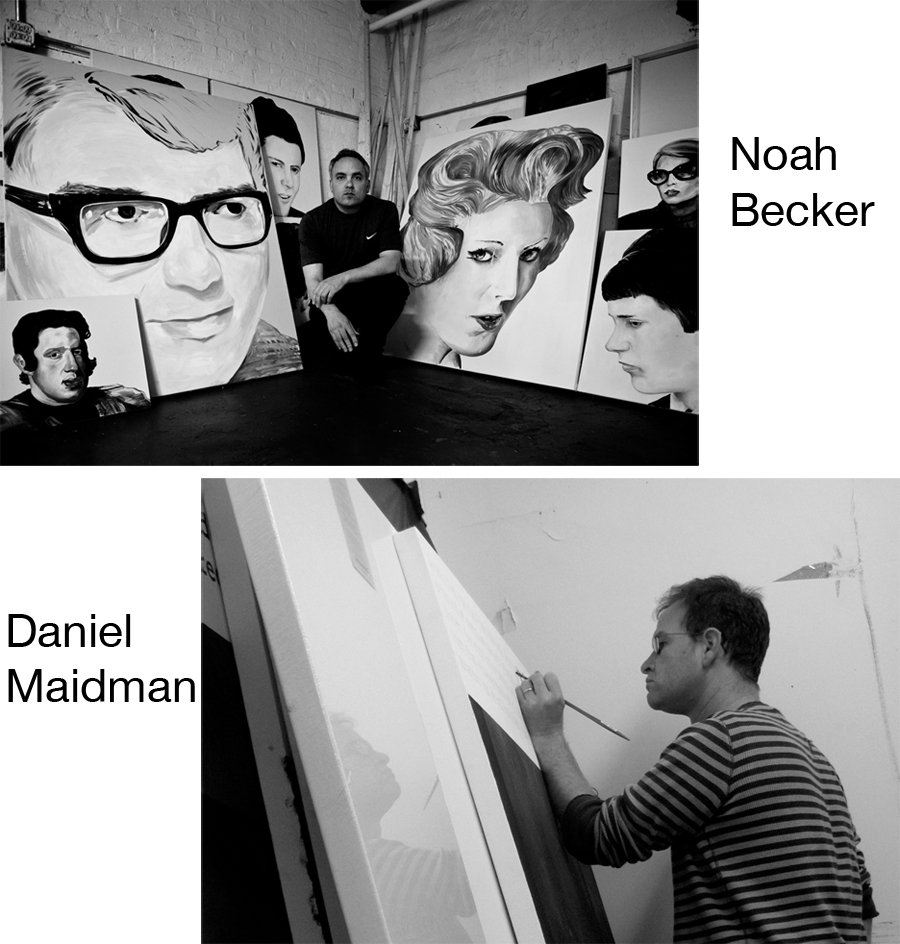
DANIEL MAIDMAN: Any thoughts?
NOAH BECKER: Let's talk about our 3 favorite paintings from history and how these works inform our own process.
DM: Really good idea.
NB: Old master if at all possible.
DM: Here are three of my Earth-shakers:
- Las Meninas, Velazquez
- Daniel in the Lions' Den, Rubens
- Venus With a Mirror, Titian
NB: I'll respond to your thoughts about them then I'll pick three and you respond to my thoughts about mine.
DM: OK.
I find Las Meninas very frightening. The people have the usual psychological resonance and depth of Velazquez people. But he has put them into a cavernous space which is indecipherable. The mirror, the door, the figure of the painter at his easel, all decompose where this is happening -- is the viewer inside or outside of the painting? This is a separate universe which traps you when you look at it.
Daniel in the Lions' Den is, to me, one of the great summaries of the human condition. It conveys the idea that we are powerful creatures, intelligent, resourceful and strong. And yet we are surrounded by hostile forces more powerful than we are, and we look upward in our terror for help. But we do not know if it will come.
I think probably all straight men have a history of incidents which taught them how to love women and what to love about them. Seeing Titian's Venus as a child is one of mine. The magical quality women have for me is right there in the white and gold goddess: intelligent, sensitive, thinking fascinating thoughts and so magnificently shaped, big and curvy, abundant.
NB: Las Meninas as far as I know is Velasquez looking at himself in a giant mirror. If you reverse Las Meninas in Photoshop it looks quite normal. The room is also reflected in the mirror.
The muscularity of the lions is amazing in that Rubens. I was at the Met this morning looking at a large Rubens. It's big screen Hollywood before Hollywood. It's wonderfully painted just a bit on the overly theatrical side based on my previous statements.
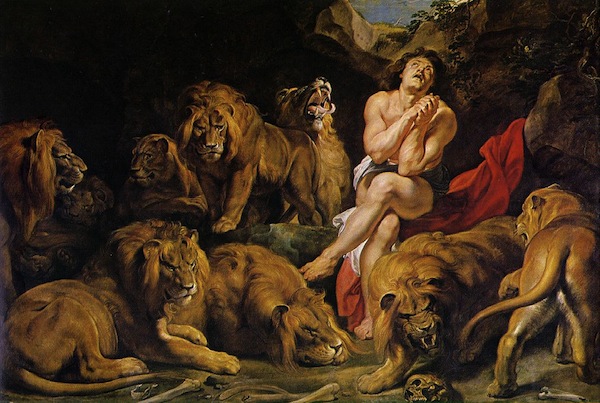
Peter Paul Rubens, Daniel in the Lions' Den, circa 1615, oil on canvas, 88"x130"
The baby is quite big in that [Titian] painting it's kind of a lecherous looking creature. I wonder why he has made a Justin Bieber size baby in that painting? Also the legs of the baby are like the muscular legs of an adult tennis player like Boris Becker or something. I've always found Titian a bit murky and never learned anything from looking at Titian. This kind of talk is shocking to certain people but I'm just being honest.
DM: Las Meninas: You're probably right about how he painted it, but that's not what it's a painting of.
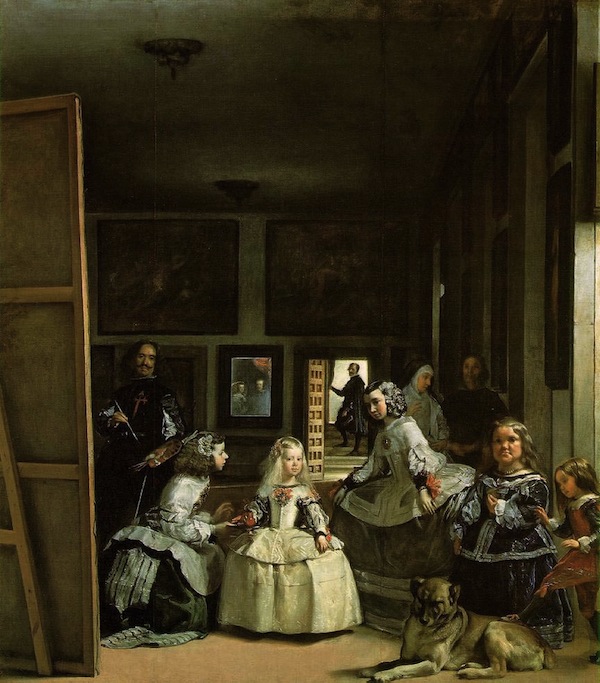
Diego Velazquez, Las Meninas, 1656-7, oil on canvas, 125"x109"
The vanishing point doesn't occur behind his head, which eliminates him as the observer. A little research suggests that most of the vanishing points end at the figure coming in the door. But there is an actual mirror in the painting, depicting the royal couple entering from the unseen real space of the painting's viewer. The false reflection is a trick he uses in the Rokeby Venus as well, but he doesn't integrate it into the perspectival space of the painting. So the narrative he constructs is that the royal couple is entering, and everyone looks up at them, including Velazquez, who is ready with his huge canvas. But he doesn't make this narrative convincing: there's the perspective problem and also the self-portrait scenario you mention. I think he does this on purpose to create a conflicted and confusing space. And there's that fearful large canvas he's working on, a canvas big enough that it should probably have Las Meninas on it -- but does it? What's on that canvas? He has added to the confusion by pulling, in part, the same stunt as Gysbrechts in his 1670 painting Reverse Side of a Painting -- he has made a painting with two backs and no front. This is one of the several ways in which Las Meninas seems not to exist.
Rubens: Yes, the muscles in his paintings are really a hell of a thing. You could probably work up a whole thing on the gendered quality of muscle and fat in Rubens, and what he's telling us about non-human entities in his paintings through his assignment of muscle-like and fat-like textures to them. I agree with you that he can veer into overstated theatricality, although we would probably cite different paintings. Not only is he Hollywood before Hollywood, I would assume that the directors, cinematographers and art directors of the Hollywood golden age period pictures actually studied him, at least a bit, to learn how to stage sumptuous history scenes.
Titian: Well, you go right ahead and confess to being a philistine. I think I might actually be able to trump you on that: I sometimes get confused as to whether I'm looking at a Titian, a Veronese or a Tintoretto. Fortunately, I like all of them. I think probably you get less out of Titian than I do because the texture of flesh isn't very interesting to you. Your paintings are much more about shape and contrast, so when I've seen you appropriating old master material in your work, it was composition you took. Composition is important in Titian, but he is above all carnal. If you don't get a tactile charge out of his work, his core vocabulary is mute to you. Visually, yes, it tends toward murkiness. As for the monster-baby, it frightens me and I don't like to think about it.
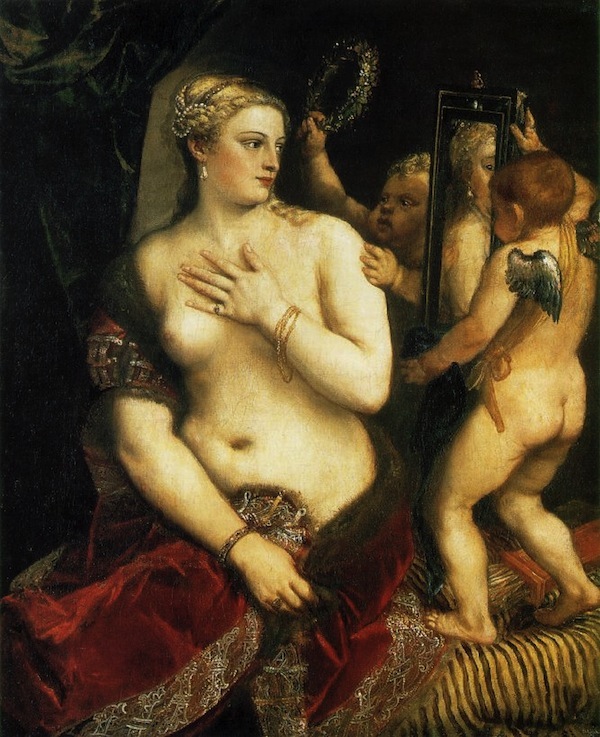
Titian, Venus with a Mirror, circa 1555, oil on canvas, 49"x41"
NB: Titian: Perhaps it is due to the paintings being old and rotten but often (as I hinted at earlier) the light in Titian is a dead light. Titian's David and Goliath (1542-44) is better for me in terms of convincing light but the overreaching problem with Titian is his illustrative quality. You can see it in David and Goliath which reminds me of NC Wyeth (October 22, 1882 -- October 19, 1945.) It's possible that NC Wyeth was influenced by Titian, I would say it's likely. The influence continues into the work of Andrew Wyeth (July 12, 1917 -- January 16, 2009) and so forth. So in a way the school of artists that follow a certain master reflect the best and the worst of that master though time. It's paint at the mercy of high drama or storyline. Andrew Wyeth kind of exploded that form in his more spontaneous watercolors. Rubens has the same problem, it's theater first then painting second. When I was learning to paint I never consulted with Titian. Also because I was a juvenile when learning to paint (14 years old) I had very dogmatic views on what good painting was -- an angry young man complex. Now I'm much more open to what's happening all over the world. In terms of Titian, because I neglected Titian for so long I now find myself discovering Titian more and more. But in terms of my work if I take a composition it's as a starting point to build on or change as I go.
Velasquez, Rubens later today...
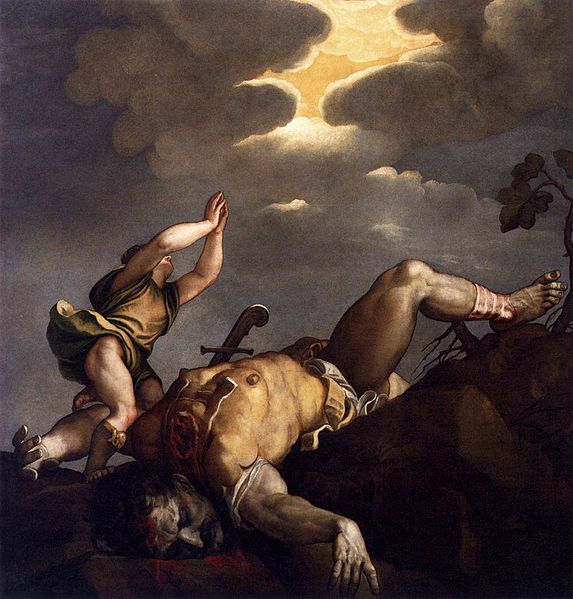
Titian, David and Goliath, 1542-4, oil on canvas, 118"x112"
DM: Will look forward to Velazquez, Rubens.
NB: We need to come to terms with how your ideology is different from mine. I don't think that is clear to the reader. Although we both are very interested in old paintings that's kind of where the agreement ends. I'm saying this for the sake of argument because it's boring to just sit around in smoking jackets patting each other on the back and worshiping other people. Yes, if Velasquez walked into my studio I would be in awe but loving something too much is a negative thing. Idol worshiping is not my idea of being a talented artist. Placing Rubens, Velasquez and Titian on a pedestal is not my aim. So now that my rant is over let me talk about your comment that I appropriate things. I do in fact appropriate old master images. I layer them and use them in the way that say Warhol would do Da Vinci? But Warhol's ideology is much more interesting than his paintings.
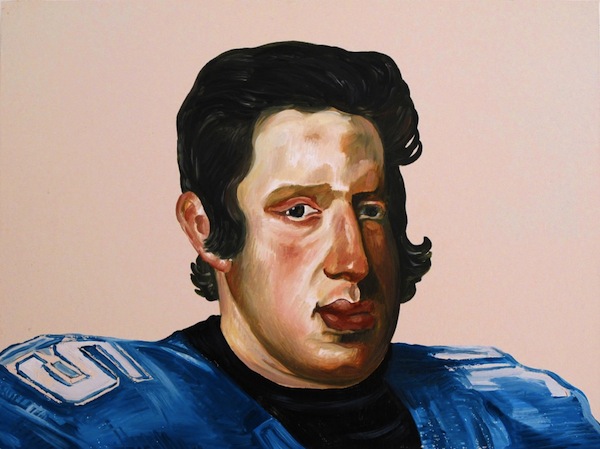
Noah Becker, Phillip IV in the Costume of Tim Tebow, 2012, oil on panel, 15" x 20"
It's happenstance that I get great pleasure from painting these things. If I was not so into painting I would be a conceptual non-painter, which I kind of am. But in the process of this it's been impossible to withdraw from making my work as paintings.
When I listen to Kanye West's new album I don't think he feels that explaining everything about Reggae or Rubens or what artists he samples is important for him in terms of being seen as a historic musician. I'm kind of sampling other art in that sense, then riffing over it and within it. This process respects and disrespects history. I don't see in your work (to respond to your statement about my work) any indication that you are disrespecting anything. I use the term "disrespect" as a means of questioning and shattering old cobweb-covered paintings or old-timey ideas about what is fair game here. I'm not afraid of these legends. We could go on and on about Las Meninas all night. The point I am also trying to make is that Picasso painting a copy of Las Meninas is as important or almost more important than Velasquez painting it. In fact all the artists who have been influenced by it are propping it up even further.
I can't fully question Velasquez though as he is a central figure in my mind and such a father to it. Rubens and Titian can come under fire more in my dialogue. The reason I brought up Kanye West is because he is more famous and influential than Velasquez, Rubens and Titian for the generation following him and in his own mind. There is no person more important than Kanye West in Kanye's mind. I want to bring more of this ego into my work and I don't see why it can't work for me. This is troubling because I think that Kanye may be a horrible person, certainly Kim Kardashian is a horrible person. So basically if it was a choice between sticking a razor through my art or through a Velasquez I guess (for whoever kidnapped me) slash the Velasquez instead of my paintings. This is a concept that most living people cannot grasp -- Kanye gets it.
DM: This is very interesting. To address the first bit, which I think would be most useful to me if taken as a critique, you remind me of something a friend of mine once said about a story I was working on. He said that I wasn't making the story as exciting as it could be, because I loved my characters too much. I didn't want to hurt them. He said, "Don't be sadistic, but do beat them up as much as the narrative logic calls for. That's where drama comes from."
Do I agree with your critique of my attitude? Of course not. But as somebody who has inspired a similar analysis at least twice, I clearly need to think about this -- about whether I'm slipping over, in the case of painting, from respect and admiration, to idol-worshipping, with the painters we've been discussing vis-a-vis my own painting. I know that I've very consciously split off from all the schools of thought that want to act as if painting stopped progressing in 1650, or 1780, or 1890. They do a great deal of good work, but whether or not it appears in my work, my own approach is that painting never stopped.

Daniel Maidman, Alley Turns Her Head, 2013, oil on panel, 16"x16"
A question: you've talked about your work in terms of conceptualism before, and in terms of origination with a mood. But this still seems vague to me. For instance, when I do figures (and I don't only do figures), I'm not doing The Figure, I'm doing this particular person, who seems to me so excellent I never want to let the sight of them go, it'll kill me to let them go; and that's where I'm painting from. That's the point where I commit myself to the work. Everything else is secondary. What's your point of core commitment? If a concept, what's the concept you're working on? If a feeling, what's the feeling? We can come back to this in a future interview, by the way, this might not be the time for it.
I feel like maybe you're getting at an answer to this question a bit with your idea of ego in the work. That seems legitimate to me -- anything is legitimate relative to the work, if not always life, as long as the outcome is good work. But, to offer a counter-critique, I am not compelled by your argument. The argument works, but I'm not necessarily buying it relative to you. I don't follow Kanye at all. Does he go around saying, "I want to bring more ego, it can work for me"? I imagine him going around saying, "All shall love me and despair!" What I mean is, if Kanye is pulling this stunt successfully, he is almost certainly starting from egotism, not ending there. My hypothetical Kanye makes images rooted in a context of egotism; he never has to mention the egotism itself. The viewer figures it out. It's not something he tries, it's something he does. My Kanye swaggers.
So my critique is -- if that's your deal, then don't aspire to it. Just do it. Swagger. From the outside, the facts conform: your work and look are cool, your magazine is called Whitehot, you play *jazz saxophone.* Don't worry about being egotistical enough; simply proceed on the basis of your awesomeness, and let judgment of the validity of your contention fall where it will no matter what you do -- with your audience.
NB: My bringing up Kanye was less about Kanye than it is about the cultural cringe. The cultural cringe is something I was researching in relation to commonwealth countries. It also applies to places like Japan, usually isolated places. It's more or less a country or city's lack of faith and lack of belief in their cultural producers. When someone from Berlin, London, Paris, New York etc. arrives on the scene, no matter how awful they may be creatively they are thought to be better and more authentic than the creatives found locally. In the case of our conversation I was thinking of this concept in more universal terms. Kanye obviously does not need to gauge his authenticity against the great musicians of the past, he seems comfortable being very forward about how great he thinks he is. As far as you go or I go I was simply probing you to see how deep your worship of the old masters was in relation to your own work. Kanye was a bit of a stretch analogy-wise as was my Justin Beiber reference but in actual fact the audience for Kanye and Justin is probably bigger than the audience for Rembrandt. You say "who cares" or is this a valid argument. Well, it's just my way of demonstrating how culture is perhaps looking at less valuable cultural things more directly. I happen to like Kanye West's new album and I find throwing in a subject outside of our conversation interesting. But I would prefer to stay on topic and continue to talk about our favorite old master paintings. I'm assuming you know more where I am coming from now. In terms of concept or conceptual approach, it's usually unskilled or de-skilled. Skill and technical prowess are not usually important in conceptual practice. You can -- and many artists do -- work in a conceptual manner using oil paint to execute ideas. I'm kind of like that but I also don't cross the line with certain paintings and cross it with others.
DM: Ah -- I first came across a description of this cringe in Ortega y Gasset, but I felt it myself long before: when I was doing science fair projects as a child. And I thought, "This isn't real science -- this is futile bullshit with construction paper -- I am far from the main artery of science." And I did not want to feel this feeling anymore. I worked very hard to be very good at everything I do seriously. So I do want to be a good technician of paint, but I don't see technique as the end goal. It's a means of maximizing the eloquence of the resources at hand. Later, I recognized that some of these feelings of futility, of cringe as you put it, are actually useful. Like most artists, I think, I would like to be cool. But I'm not willing to be anything but myself about it. So my own approach is to be as uncool as my nature demands, but to do it with integrity and as much honesty as I can bring. And I figure that's where cool comes from; from not worrying about it too much. So part of my uncool nature is the sense of terror at being far from the main artery of science, or of art. But I'm not afraid as a child is afraid; I'm working on bending the path of the artery, and broadening its diameter. I also have a steadfast belief that I am the awesomest artist ever. We all do, right?
This brings me around to your question about my degree of worship of the masters. The way I think of it is, there is a table. The masters sit around the table like Viking heroes, having a mighty conversation with one another. I'm not looking to refill everybody's glasses or bus the dishes. I want to earn my chair at the table, and moreover, I think I will. It's not worship. It's an ambition for membership. There is an anecdote about Picasso, seeing his own painting hung beside a Velazquez, I think, where he betrays similar feelings; although I had the feelings before I knew the anecdote.
I think I do understand a bit better where you're coming from now, but I'm interested to read your thoughts about the paintings you chose -- I'm ready to move along to them if you are, although obviously there is more to discuss along this line of thought if you'd like to keep going a bit more.
NB: OK then I suggest we open up the conversation about the three paintings I picked.
TO BE CONTINUED
---
Noah Becker is an acclaimed oil painter, a jazz saxophonist, and the founding editor of Whitehot Magazine. He is also a contributing writer for Art in America, Interview Magazine, Canadian Art, The Huffington Post, ARTVOICES and New York Arts Magazine. His work was recently exhibited in Detroit with David Shrigley and Michael Borremans in a show curated by Dick Goody. He's showing in two future shows organized by curator Kristin Sancken. His work debuts in London in July at Flowers Gallery in a group show of self portraits. He is showing with artist/curator Aubrey Romer at Art Hamptons. He will have a solo show at the Lodge Gallery on Christie street in New York this November. Becker lives and works in New York City.
Daniel Maidman is a Brooklyn painter whose art has been shown in group and solo shows in Manhattan, was selected by the Saatchi Gallery to be displayed at Gallery Mess in London, and has been exhibited at the Alden B. Dow Museum of Science and Art. His art and writing on art have been featured in ARTnews, The Huffington Post, International Artist, Poets/Artists, MAKE (forthcoming issue), Manifest, and Catapult. His work is included in numerous private collections, among them those of New York Magazine senior art critic Jerry Saltz, Chicago collector Howard Tullman, best-selling novelist China Miéville, Disney senior vice president Jackson George, author Kathleen Rooney, and Gemini-winning screenwriter Jeremy Boxen.
Velazquez, Rubens, and Titian images via wikimedia.org
